Bugs! They’re What’s For Dinner
Montclair State anthropologist’s research suggests nutritious insects hold the key to food security and saving endangered lemurs in Madagascar
Posted in: Research, University
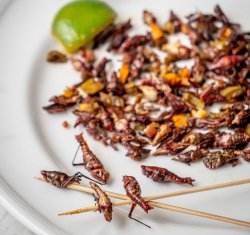
What would an insect need to taste like for you to add it to your diet? How about … bacon? That smoky flavor seems to be the secret behind a Montclair State anthropologist’s success in improving nutrition and saving lemurs in Madagascar through farming the crunchy Zanna tenebrosa, aka the “bacon bug.”
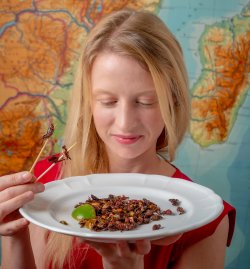
“We knew they were delicious – they taste just like bacon – but it turns out that they’re also nutritious,” says Assistant Anthropology Professor Cortni Borgerson. “The farms we’ve created are really taking off, and insect consumption has increased by more than 1,000%.”
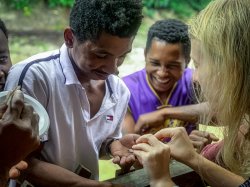
And beyond that, the more insects are eaten in the wilds of Madagascar, the fewer endangered lemurs will be hunted, which has long been Borgerson’s goal.
Until last March, Borgerson split her time each year between the manicured campus of Montclair State and the wilds of the Masoala Peninsula on northeastern Madagascar, where, for the past 15 years, in one way or another, she has been working on both lemur conservation and improving malnutrition. In the last year, her grant-funded project to farm these “bacon bugs” is proving to solve both problems.
Her last trip to Madagascar was this past Spring Break, when, while she was there, the World Health Organization declared a global pandemic, and many areas of the world locked down. Getting back home was an adventure in itself – starting with having to wait out a cyclone before being able to leave the island in the Indian Ocean off the east coast of Africa.
“I managed to get on one of the last flights out of Madagascar before everything shut down,” says Borgerson, “but our work continues here, as well as [in Madagascar], thanks to our incredible research team there.”
Borgerson has been traveling to the same area near the Masoala National Park since she was a graduate student at the University of Massachusetts and a postdoctoral fellow at Harvard, long before she joined the Montclair State faculty in 2018. She is fluent in Malagasy and in the local dialect in the Masoala region, where locals first introduced her to “sakondry,” the Malagasy name for the bug that tastes like bacon.
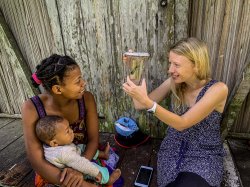
Villagers thought the sakondry were tasty but hadn’t considered it a sustainable food source, Borgerson says. When people get hungry and desperate there, they turn to the forest. Her original studies in Madagascar showed that in some villages, 75% of animal-source foods come from forest animals, including lemurs, and that there are higher rates of malnutrition in households that hunt lemurs, indicating that lemur is a “last resort” food. The sustainability of farming the tasty little “bacon bug” was worth exploring as an alternative food source, especially since they were already picked off plants and fried up in the rainy season as a special treat.
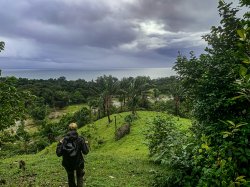
So, when she returned to Montclair State for the fall 2019 semester, she sought the help of entomologist and Assistant Biology Professor Matthew Aardema to develop ways to farm the bug and better understand the biology of this little-studied insect.
Aardema says Borgerson’s program to farm the sakondry in food insecure communities “has the potential to significantly improve the quality of life for those individuals who will have direct access to these insects.”
As Borgerson explains, “There is a clear correlation between malnourishment, food insecurity and lemur hunting. But that also makes it a very solvable problem. We just need to change what people put on top of their rice.”
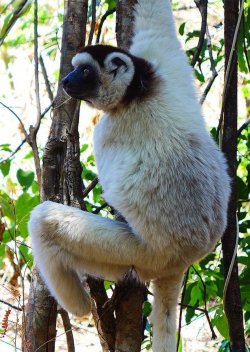
After getting the nutrition results and designing farming protocols in the fall of 2019, Borgerson’s team has been establishing farms of “tsidimy,” the lima bean plant that attracts the bacon bug, in villages throughout the Masoala region where the rainforest meets the sea.
Borgerson’s team received a three-year grant from The International Union for Conservation of Nature’s Save Our Species initiative as well as support from National Geographic and Montclair State to test sakondry farming methods as a lemur conservation effort.
Their project is set in three of the Masoala Peninsula’s remote communities. “Our furthest communities are about four days beyond the last village on the map,” Borgerson says.
Her team of 15 research staff distributed lima bean plant seeds to participating households and there are now about 4,200 plants growing across all three project communities. The beauty of farming the “bacon bugs” is that they eat the “phloem” of the plant but not the lima beans, so people can harvest both. “It’s a win-win,” Borgerson says.
Early results show that farming sakondry has already begun to improve child nutrition, food security and lemur conservation. “There’s now food available at the times when people might typically hunt primates,” she says.
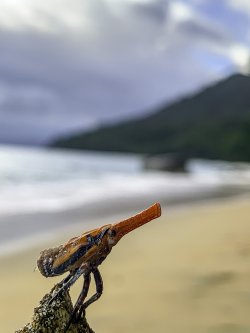
According to the most recent estimates, nearly 90,000 harvestable sakondry had found each of the communities’ lima bean farms, creating enough food from sakondry to replace 100% of lemur meat, and halve lemur hunting, since the project began a year ago, which had been their original three-year goal, Borgerson says.
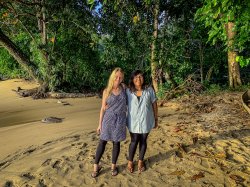
Borgerson’s work in Madagascar has made her a bit of a celebrity in conservation circles. She has led National Geographic Expeditions and guest-starred on two episodes, where she helped the show’s hosts navigate Madagascar in search of animals thought to be extinct. Her work has also been featured on Vox and Atlas Obscura.
She serves on the board of the NGO Madagascar Health and Environmental Research (MAHERY), and is a commission member for the Madagascar Section of the International Union for Conservation of Nature Species Survival Commission’s Primate Specialist Group.

Pre-pandemic, she traveled to Madagascar in the summers and on winter or spring break, often with her husband and young daughters in tow, but since her last trip in March, she has had to find ways to do her research long-distance.
“We can’t wait to get back into the field,” she says. “Madagascar is our second home.”
Borgerson teaches Introduction to Physical Anthropology, Environmental Anthropology, Human Culture for Biodiversity Conservation, and Planetary Health. In the summer of 2019, Biology major Patsy Herrera ’20, traveled to Madagascar with Borgerson to assist.

It was a life-changing experience. “It made me realize how much is out there, diversity of nature, culture and language,” Herrera says. “It made me want to keep pursuing my interests in horticulture and ecology that is multi-culturally responsive. I also developed a massive appreciation for insects!”
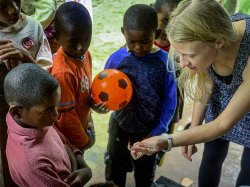
The sakondry program is part of broader efforts in Madagascar to boost insect consumption to reduce malnutrition and protect biodiversity – including the use of cricket powder in school lunches in the capital city.
There’s also a push worldwide for more insect consumption – crickets, grasshoppers and other edible bugs – for both nutritional and environmental reasons. Harvesting insects requires less land and water and produces fewer greenhouse gases than harvesting meat. “They’re a great source of protein, vitamins and minerals,” Borgerson says. “And the fact that this one tastes like bacon helps.”
Too bad it’s mostly found in abundance in Madagascar.
